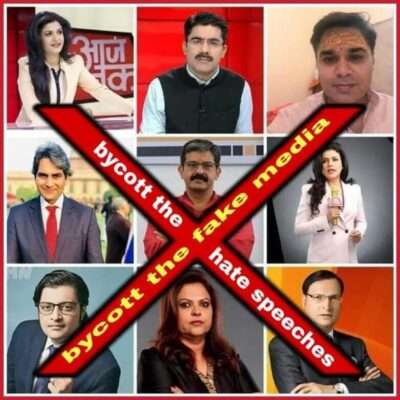In India, media holds a pivotal position in shaping public opinion, disseminating information, and acting as the fourth pillar of democracy. While the media plays an essential role in providing news and holding those in power accountable, there have been instances where it has been criticized for misleading the common citizen. This article delves into some of the ways in which Indian media can unintentionally or intentionally mislead the public.
- Sensationalism over Substance: One of the common criticisms of Indian media is its penchant for sensationalism. Sensational headlines and news coverage can distort the facts and focus on the dramatic or emotional aspects of a story rather than the substantive issues. This not only misleads the audience but also distracts from critical matters.
- Bias and Agenda-Setting: Media outlets often have their own biases and political affiliations, which can influence the way they present news. Whether it’s a preference for a particular political party or sensationalizing certain issues while downplaying others, bias can lead to a skewed understanding of events.
- Lack of Fact-Checking: In the era of instant news, fact-checking can sometimes take a backseat. Incorrect information or unverified news stories can spread quickly, creating confusion and panic among the public.
- Overemphasis on Entertainment: Some news channels blur the lines between news and entertainment, prioritizing sensational celebrity gossip and reality TV over serious journalism. This can mislead viewers by diverting their attention from important issues.
- Incomplete Coverage: Media sometimes provides incomplete or one-sided coverage of events. Focusing only on one aspect of a story can lead to a distorted understanding of complex issues.
- Social Media Amplification: Social media platforms have become powerful tools for news dissemination, but they can also be hotbeds for misinformation. False or misleading information can spread rapidly through social media, further contributing to the problem.
- Pressure from Advertisers: Economic pressures from advertisers can influence media organizations to prioritize certain stories or avoid others that may be critical of their sponsors. This can lead to a lack of transparency and objectivity.
- Hasty Reporting: Breaking news often requires quick reporting, and in the rush to be the first to report, media outlets may not have all the facts. This can result in inaccuracies and a premature understanding of events.
It’s important to note that not all media outlets engage in these practices, and many journalists and organizations uphold high standards of journalism. However, the presence of misleading or biased reporting in some sections of the media landscape highlights the need for media literacy among citizens. It’s crucial for individuals to critically evaluate the news they consume, cross-check facts, and seek out reliable sources to form a well-informed understanding of current events. In a democracy, an informed and discerning citizenry is essential for holding the media accountable and ensuring that it fulfills its role as a watchdog and provider of accurate information.
Comprehension Questions
What is the primary role of media in a democracy, as mentioned in the article?
a) To generate profits for media organizations
b) To entertain the public
c) To shape public opinion and provide information
d) To promote government propaganda
How does sensationalism in media coverage impact the presentation of news, according to the article?
a) It leads to more accurate reporting
b) It focuses on facts and figures
c) It prioritizes emotional and dramatic aspects
d) It encourages calm and rational discussions
Explain the term “media bias” as discussed in the article.
a) A lack of interest in reporting current events
b) An inclination towards objective reporting
c) A tendency to present news from a particular perspective
d) A commitment to unbiased journalism
What potential consequences are associated with media bias, according to the article?
a) Increased transparency in journalism
b) Enhanced trust in media organizations
c) A skewed understanding of events
d) A reduction in the influence of advertisers
Why is fact-checking emphasized in journalism, as per the article’s content?
a) To slow down the news reporting process
b) To increase the sensationalism of news stories
c) To ensure the accuracy of information presented
d) To attract more advertisers
How does the blurring of lines between news and entertainment affect journalism and audience understanding, according to the article?
a) It promotes objective reporting
b) It encourages in-depth analysis
c) It diverts attention from important issues
d) It leads to more informative news broadcasts
What role does social media play in the spread of false information, according to the article?
a) It has no impact on the spread of false information
b) It serves as a reliable fact-checking platform
c) It can facilitate the rapid spread of false or misleading information
d) It only shares verified news articles
How does economic pressure from advertisers influence media organizations, as discussed in the article?
a) It promotes investigative journalism
b) It encourages a focus on critical issues
c) It can lead to prioritizing certain stories or avoiding critical ones
d) It has no impact on media content
What potential issues can arise from hasty reporting, as mentioned in the article?
a) Increased accuracy in news coverage
b) Improved understanding of complex issues
c) The spread of inaccuracies and premature conclusions
d) More time for in-depth reporting
What is the suggested role of media literacy in the article, and why is it important in a democracy?
a) Media literacy is not important in a democracy
b) Media literacy is important for critically evaluating news and holding media accountable
c) Media literacy is only relevant for journalists
d) Media literacy is primarily focused on sensationalism
Write Summary of the the article as per your understanding

